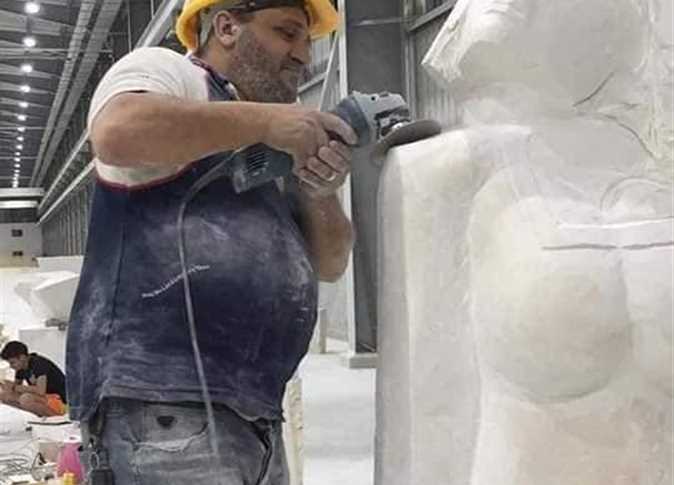Monday, 11 January saw the opening of sculptor Salah Eddin Abdel Rahman’s solo exhibition at the Easel and Camera Contemporary Art Gallery.
The intimate display space is located in an unlikely area, a big mall right on Maadi’s busy Nasr Street, but as enthusiastic Gallery Manager Weeam El-Masry puts it, “this abnormal location has its pros, as it bring us a lot of visitors by coincidence.”
What is certain, though, is that the friendly crowd that gathered on Monday evening for the opening of Abdel Rahman’s exhibition did not enter the tiny premises randomly, and all seemed to have been driven by an acute appreciation for art.
Thanks to a couple of energetic and chubby kids running around and patting the visibly unmoved rock sculptures, the gallery resonated with a joyous ambiance seldom felt in a space dedicated to art.
Displayed throughout the gallery are 12 sculptures of faces, sometimes with a bust attached, all exuding a very peculiar strangeness coupled with an unmistakable attractiveness.
The first sculpture that catches one’s attention is a woman’s face in sparkling white marble. For the eyes, the sculptor fixed a net and shallow drain in the porcelain-white marble, blurring the woman’s window to the soul and preventing the observer from deciphering her emotions.
The soft lines that run down her long dove-neck give the woman a queenly bearing. “I intentionally give the faces I sculpt a blurry aspect, so they look soft on the outside but hide various levels of emotions,” the artist explains.
Three sculptures in granite, arranged in an aesthetic triangle, are taken to another level of abstraction. A round, bald grey face is reduced to its simplest expression without any rough edges of the rock to disturb its smooth appearance.
Close to it, scarce womanly features emerge out of pink granite, revealing a slightly tilted head immersed in thought. Thick locks of hair fall neatly on her barely sculpted shoulder, following the curve of her face. The last sculpture that belongs to this inspirational trio is also in granite, though of a lighter shade. Here again the features are merely evoked, as if whispered to the ear of the visitor who succombs to the peaceful anonymity of the character.
A little further, an exquisite diamond-shaped face sculpted in white marble somehow reminds the viewer of an African statuette. One blank eye, pierced in the flesh of the rock, is evident while the other is hidden by a curly lock that surprises in the midst of these geometrical lines.
A few steps on, two tall totem-like statues are displayed, all rectangular and narrow. The artist carved straight lines into the rock that seems to have bent to his will. The disproportionate size of the nose that runs from the tip of the forehead and almost brushes the full-lipped mouth of the sculpture, and the indecipherable look expressed through the frozen eyes, are mesmerizing.
Surprisingly enough, the sculptor drew his inspiration from ancient Egyptian art to create these pieces. “Look at the forehead; I carved a protuberant parting of hair that is an abstract version of the sacred cobra which pharaohs wore on their wigs,” he explains, running his finger down the statue’s flat back.
The last piece worth mentioning is one representing the sound-asleep face of a very young child, also in white marble. His thin lids cover his resting eyes like pieces of transparent silk, while his face bears the true expression of peacefulness.
But the general harmony of the sculpture is rent apart by two copper microphones sticking out of the child’s ears. “This is the sneaky person par excellence,” confesses the sculptor, pointing at the microphones. “He is constantly listening to whatever is being said around him, while draping his face with innocence,” he explains, showing the peaceful face to be a mask.
Abdel Rahman says that this baby face is his first experiment with marble, which he sculpted four years ago. Before that he used to work solely with materials such as polyester, copper, clay, bronze and granite.
The sculptor concludes by saying that his love for granite came from “the rock’s ability to forgive a mistake. Marble, on the other hand, is a very complex rock to work with, as the tiniest error instantly becomes a major one.”
The exhibition runs till 31 January
Salah Eddin Abdel Rahman’s solo exhibition
Easel and Camera – Contemporary Art Gallery
11/2 El-Nasr st., beside HSBC bank, Maadi, Cairo, Egypt
010 183 4449
www.easelandcamera.com
Daily from 4 to 10 PM




